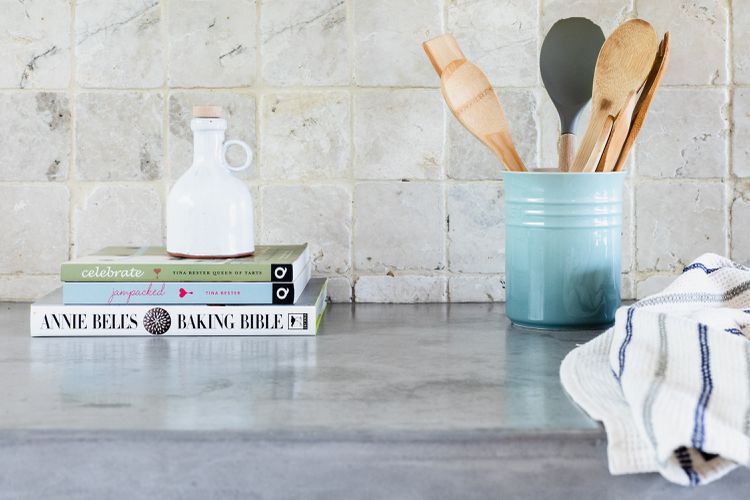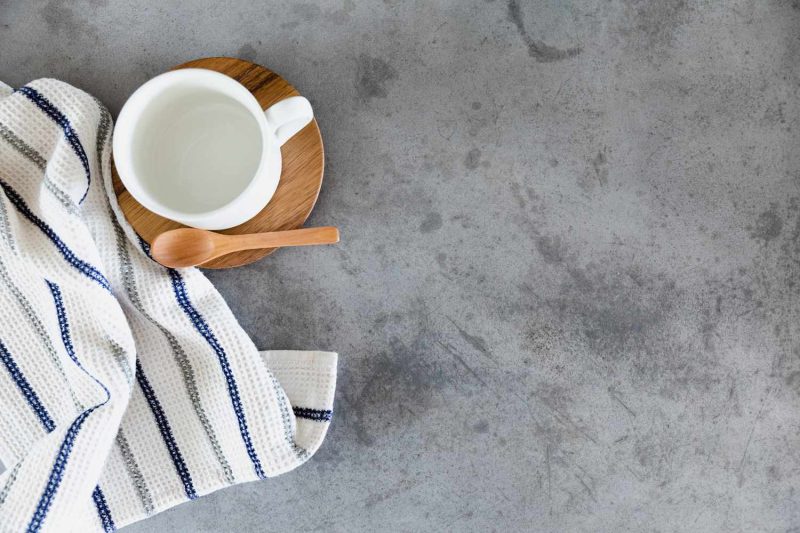
High-end concrete is often misinterpreted when it comes to kitchen countertop materials. With its durability comparable to granite or slate, concrete may actually be a more suitable choice for modern kitchen designs than both engineered and natural stones, as it offers a sleek, industrial look.
Enhancing the allure is the ability to manipulate concrete through techniques such as etching, acid staining, stamping, and sealing, resulting in a countertop that stands out from nearly all other materials. Today’s concrete kitchen countertops have evolved from being mere cold, gray slabs to becoming inviting and polished surfaces that are both practical and exceptionally chic.
However, concrete does come with notable drawbacks that warrant careful consideration before making a purchase.
During the installation process, the team might construct or set up support structures for sinks, as the countertop should not bear the sink’s weight. In the case of an under-mount sink, it is positioned first, followed by the installation of the countertop above it. Typically, the countertop is secured to the cabinets using construction adhesives, ensuring it is properly leveled and shimmed beforehand.
Contents
Advantages and Disadvantages of Concrete Countertops
- Can be tailored to specific dimensions and forms.
- Challenging to mark and resistant to high temperatures.
- Minor objects can be incorporated.
- Robust and enduring
- Can enhance resale value as it is regarded as a high-quality surface.
- High-priced, with costs reaching $135 or more for each square foot.
- Consistent sealing is necessary to prevent discoloration.
- Its heavy weight can put a strain on cabinet structures and flooring.
- Fixing things can be challenging for those who prefer to tackle projects on their own.
Pros
A concrete countertop boasts numerous advantages, particularly its capacity to be customized to fit your kitchen’s specific measurements and to be finished to your exact preferences. Unlike other countertop materials, which often restrict you to a limited selection of colors and designs, concrete provides a broader array of possibilities. The only other material that comes close to matching this level of variety is ceramic tile.
- Although concrete is not completely immune to scratches, it offers impressive resistance to them, particularly when contrasted with softer countertop materials like solid surface or laminate.
- Concrete can also be personalized by incorporating various small elements into its surface. Items such as glass shards, pebbles, seashells, and even fiber-optic lighting can be integrated into the mix.
- In the appropriate home, concrete countertops can enhance the property’s resale value, as they are regarded as a high-end material, comparable to quartz or natural stone surfaces.
Cons
If you typically associate concrete with its practical applications in slabs and foundations, you might assume that concrete countertops are inexpensive and straightforward to install. However, that perception is quite misleading. When utilized for kitchen countertops, concrete is considered a premium material, and creating these surfaces demands the expertise and craftsmanship of skilled professionals.
- If you dislike routine upkeep, concrete might not be the best choice for you. At the very least, it needs to be resealed once a year.
- Due to the substantial weight of concrete, it is often necessary to reinforce cabinets and flooring to support the added load.
Price of Concrete Countertops
Concrete countertops can be quite costly. The common misconception that concrete is a budget-friendly material, typically associated with sidewalks and patios, is misleading. Anticipate a price of $135 per square foot or higher for comprehensive fabrication and installation of concrete countertops.
Due to their considerable weight, concrete countertops can range from 19 to 25 pounds per square foot, which may necessitate additional support for cabinetry and flooring to accommodate this load. If reinforcement is needed for your installation, it can lead to a notable increase in overall expenses.
Upkeep and Restoration
If the countertop was initially treated with a premium sealer, regular upkeep involves applying a quality water-based wax sealer every 9 to 12 months. This annual sealing helps the surface to resist stains, which is crucial since concrete is a porous material that can easily absorb stains. However, it is advisable to promptly clean up any spills, particularly those from acidic or heavily staining substances like red wine, citrus juice, tomato sauce, or curry, as they can lead to staining if they come into contact with areas where the sealer is damaged or worn.
Select a sealer designed to endure high temperatures if you plan to place hot cookware directly on your concrete countertops. While concrete can handle significant heat, sealers not specifically made for heat resistance may become discolored when in contact with a hot pot or pan. If you are unsure about the type of sealer used on your countertops, it’s wise to err on the side of caution and refrain from placing hot cookware on them until you can confirm that a heat-resistant sealer has been applied.
When preparing food on your concrete countertops, it’s advisable to utilize a cutting board. Although the concrete is generally resilient, the sealer may become scratched or chipped, revealing the concrete beneath and increasing the risk of staining.
For routine cleaning, consider using a gentle soap mixed with water to clean your countertops on a daily basis or as frequently as you prefer. Avoid using harsh, abrasive cleaning agents, as they may harm the sealant.
It’s important to note that concrete countertops often form minor hairline cracks as they age, a result of the natural shrinkage that occurs during the drying process. For numerous individuals, these cracks add a unique charm and a sense of history to the concrete surface. On the other hand, significant cracks typically arise from poor installation practices, like setting the countertop on uneven cabinets. While these larger cracks can be patched and fixed, they are likely to reappear if the root cause is not resolved.
Design
Sleek gray concrete countertops may be ideal for contemporary kitchens, but they are far from the only choice available. Concrete surfaces are incredibly adaptable and can be tailored to fit the aesthetic of any environment. Unlike stone, which is mined and cut, concrete is poured and shaped during installation, allowing for the creation of curves, edges, and unique forms. Additionally, you can embed small items like stones, colored glass fragments, shells, or metal chips into the wet concrete. However, it’s advisable to use these embellishments sparingly, as they may compromise the practicality of the countertops.
When considering color choices, the possibilities are endless. While light gray is a classic option, you can easily incorporate a range of colors into the wet concrete to achieve nearly any shade you desire. Opt for a darker palette with rich gray, navy, or black. Alternatively, you can choose vibrant concrete countertops or go for a more subdued, earthy palette with shades of brown, beige, or terracotta. White concrete countertops are also an option, but keep in mind that lighter surfaces will require more frequent cleaning, as any spills or drips will be quite noticeable.
Concrete can be treated with acid etching to achieve a weathered, aged look, or it can be designed with veins to mimic the appearance of marble. The surface can be finished with a matte, glossy, or a combination of both.
When selecting the design, hue, and texture of your concrete countertops, it’s essential to take into account the overall aesthetic of your home, the other colors present in the area, the appearance of the existing flooring and cabinetry in the kitchen, and the effect you wish the countertops to have on the space.
Installation of Concrete Countertops
Concrete countertops might appear to be thick slabs, but they typically measure only 1.5 to 2 inches in thickness. The perception of greater thickness often comes from the design of the drop-front edge on the countertop.
Although concrete countertops can occasionally be created and poured directly at the location, they are more commonly manufactured in workshops. This process begins with a technician taking accurate measurements of your kitchen and reviewing all available finishing options with you.
In the workshop, the countertops are crafted, and the surfaces are poured, incorporating any requested sink cutouts, colors, or additives. Throughout the manufacturing process, the countertop slabs are typically strengthened with fiber or metal mesh to enhance their durability and stability.
Once the countertop has been manufactured, it undergoes a complete curing process, after which the surface can be ground and polished to the desired finish specified by the client. A sealer, typically a durable epoxy, is then applied. After the curing and finishing stages are finalized, a team of installers meticulously transports the countertop to the job site and carries out the installation.

Are Concrete Countertops Suitable for Your Needs?
If you’re in the market for new kitchen countertops, concrete is an option that should be on your radar. This material is incredibly durable, capable of lasting for many years with the right maintenance. Additionally, the design possibilities are virtually limitless. You can personalize the color, finish, and even the shape of the countertops. Whether your aesthetic leans towards a cozy farmhouse vibe or a contemporary, minimalist look, concrete can complement it beautifully. Plus, maintaining concrete countertops is relatively straightforward.
Nonetheless, like any other material, concrete has its drawbacks. Installing concrete countertops can be costly, and you might need to reinforce your current cabinets and flooring. The curing process for concrete can take several days, meaning you won’t be able to use the countertops immediately after they are installed. Additionally, significant repairs typically necessitate the assistance of a professional.

